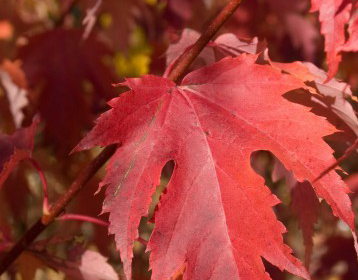The University of Minnesota developed and introduced the Firefall Maple Tree. It is a fast-growing tree that can withstand the cold winters and hot summers of Minnesota. This seedless Firefall Maple Tree has a beautiful red fall color. It’s a hybrid of Autumn Spire and Silver Maples. Firefall Maple Trees are oval-shaped and upright, thus they are narrower than Autumn Blaze Maples. Firefall Maples thrive on a range of soils.
The Firefall maple’s most attractive feature is its fall crimson leaf show. As the days grow shorter and the temperature drops, this tree’s leaves transform into a vibrant tapestry of flaming red hues. Because of its gorgeous shade, which adds an element of elegance and warmth to any landscape, it is an appealing option for people looking for an attractive fall display.
Firefall Maple Tree Pros and Cons
Pros
When it comes to adding beauty and charm to the environment, there aren’t many trees that can compare to the Firefall Maple. It has become popular with both homes and landscapers because it grows quickly and possesses bright red leaves.
This Firefall Maple is an excellent choice for establishing a mature and entrenched landscape in a brief period. The average height of this tree is two feet every year. A mature Firefall Maple can provide shade and aesthetic value in as little as three growing seasons, thus saving one’s time and effort.
The Firefall Maple’s rapid growth rate can be attributed to its ability to effectively convert sunlight into energy through photosynthesis. Their large, dark leaves shield the tree from the sun and provide a lot of nutrients, allowing the tree to flourish. Additionally, the Firefall Maple has a robust root system that efficiently pulls water and nutrients from the ground, assisting in the tree’s rapid growth.
Firefall maples have exceptionally robust branches that are resistant to damage from wind, snow, and ice due to the constantly great branch angles of attachment to the trunk. Firefall Maple also requires less pruning.
Cons
The Firefall Maple is a beautiful and useful tree, but its strong root system can cause problems for certain homeowners. This tree’s roots tend to spread widely and grow near the ground, which causes them to frequently obstruct sidewalks, roadways, and even building foundations.
The Firefall Maple’s broad, shallow root system quickly absorbs water and nutrients. However, if the roots encounter obstacles along their path, this can result in pavement material displacement and structural damage.
Firefall Maple Tree Care
This Firefall Maple needs little care once it has established itself in its surroundings. This tree is generally self-sufficient. It can flourish without much help after it’s settled in, saving both time and effort.
The Firefall Maple requires less maintenance because of its flexibility and toughness. They can thrive in a variety of soil varieties, such as clay, loam, and sandy soils, as long as they are well-drained. This tree is also fairly drought-tolerant once it is fully grown, but it does better if it is watered regularly during long dry times. With the proper care during the initial establishment period, the Firefall Maple can become a self-sustaining and resilient addition to the landscape.
Firefall Maple Tree Problems
The Firefall Maple’s quick growth makes its wood fragile. This tree grows quickly, but the wood it produces is mostly less dense than usual, making it more likely to break in severe weather.
The Firefall Maple is a beautiful addition to any setting, but it can become invasive if it is allowed to outcompete other plants. The Firefall Maple has the potential to rapidly grow and take over the ecology of non-native places, resulting in a loss of biodiversity. The propensity of the Firefall Maple to develop branch or trunk fractures is an additional disadvantage. A few of the reasons for these fissures are mechanical stress, fungal infections, and extreme temperature changes.
Firefall Maples often produce suckers or branches from their trunks or roots. Due to their vitality and rapid growth, these suckers can deplete the parent tree of energy and resources.



